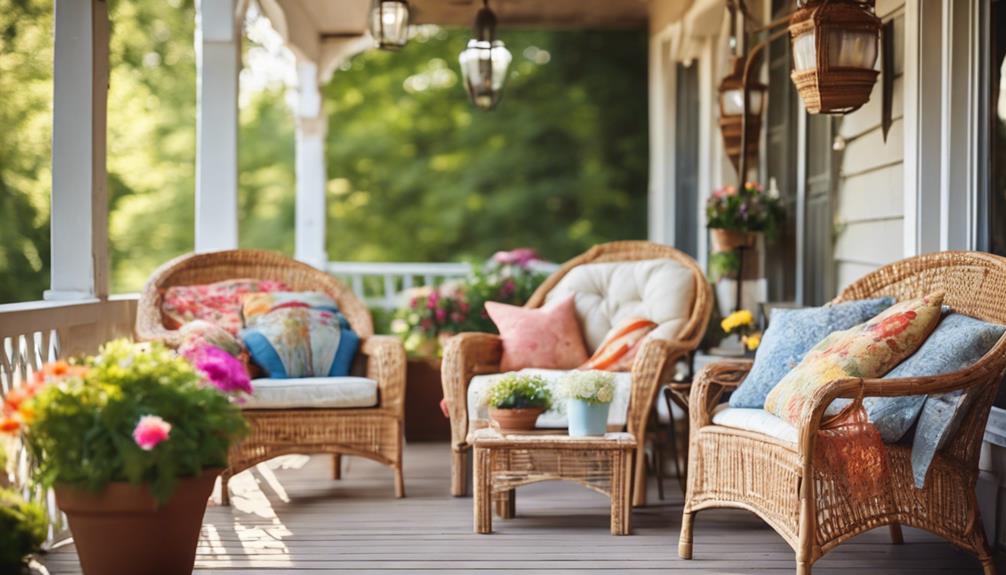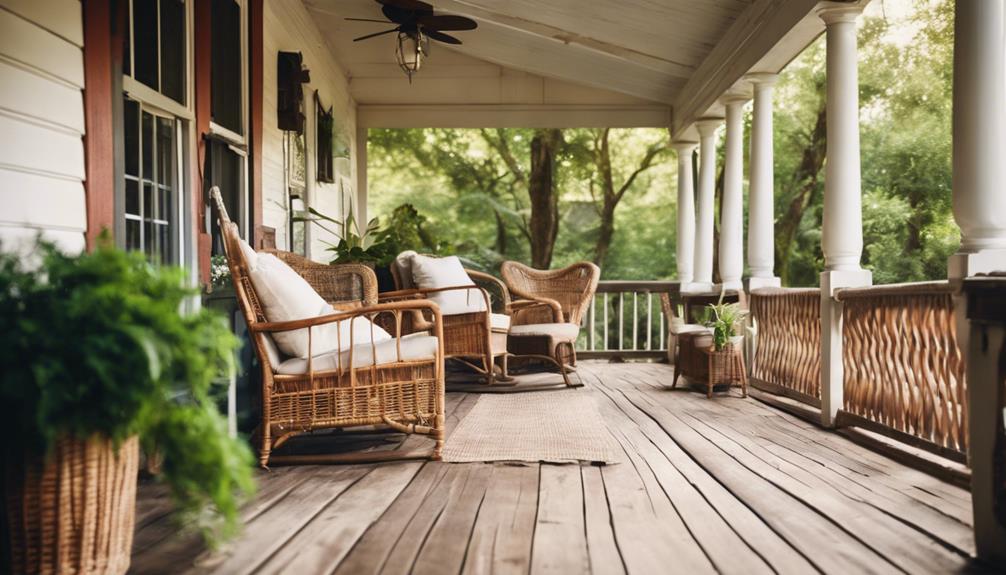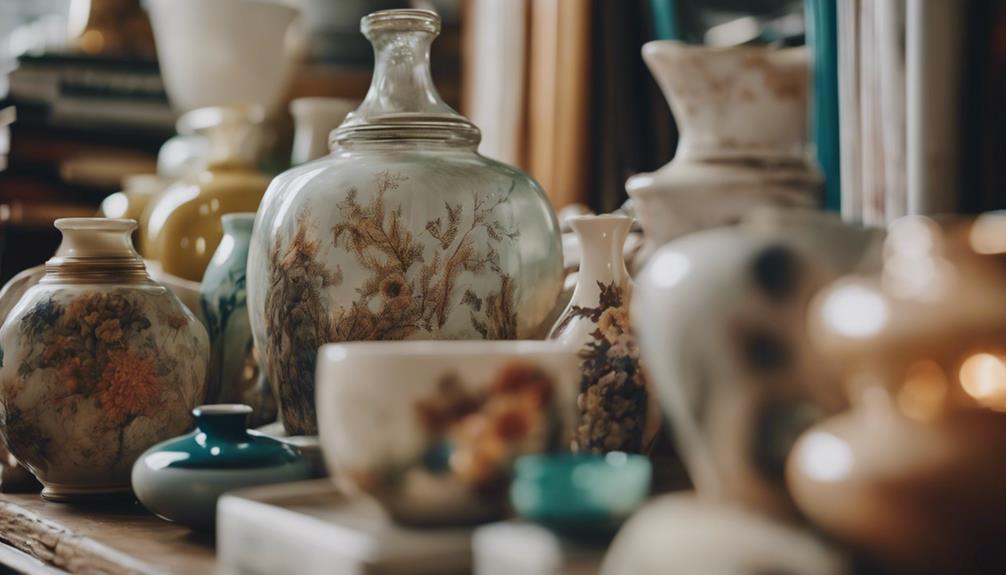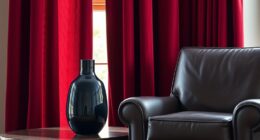When deciding between wicker and wood for your country porch furniture, take into account your lifestyle and preferences. Wicker, typically made from synthetic resin, is lightweight, weather-resistant, and requires minimal maintenance, making it perfect if you desire a colorful and laid-back atmosphere. Wood, such as teak or eucalyptus, exudes timeless elegance and distinctive grain patterns but requires regular upkeep to maintain its pristine appearance. Consider the climate of your porch and how much time you are willing to devote to upkeep. Each material has its own appeal, and your decision will influence the ambiance of your outdoor space. There is more to learn about making the best choice.
Key Elements

When choosing between wicker and wood for your country porch, consider the key elements of color scheme, materials, and textures.
These factors can greatly impact the overall vibe of your outdoor space.
Color Scheme
How do you choose the right color scheme for your country porch furniture to enhance its charm and blend with the natural surroundings?
Start by considering earthy tones like browns and greens, which complement the rustic aesthetic typical of country settings. If you opt for wicker, you'll find a variety of color options available, from traditional neutrals to vibrant hues. This versatility allows you to create a playful or sophisticated design that matches your personal style.
For wooden options, natural finishes like teak or cedar can beautifully showcase the grain, while painted pieces in pastel shades evoke classic country charm. When selecting colors, don't forget to incorporate accent colors through cushions and accessories. Wicker's ability to blend with colorful fabrics makes it easier to achieve a cohesive look than the more subdued tones of wood.
Also, keep seasonal changes in mind. Choosing fade-resistant finishes for both wicker and wood guarantees your furniture maintains its color and appeal despite varying weather conditions.
With these considerations, you can create a stunning color scheme that enhances your country porch's overall beauty.
Materials
Choosing the right materials for your country porch furniture can greatly influence both its aesthetic appeal and practicality.
Wicker furniture, made from synthetic resin or natural fibers like bamboo and rattan, offers a lightweight and weather-resistant option ideal for outdoor use. This versatility allows you to choose from various colors, enhancing your porch's atmosphere while requiring minimal maintenance—often, a simple hose down is all it takes to keep it looking fresh.
On the other hand, wooden patio furniture, particularly pieces made from durable woods like teak or eucalyptus, brings a classic beauty to your outdoor space. However, wood requires more care; you'll need to regularly seal or stain it to protect against the elements. The unique grain patterns of wood add elegance, but this comes at a higher price point compared to wicker.
Budget-wise, if you're looking for cost-effective materials for your country porch, wicker generally offers a more affordable solution.
Ultimately, your choice between wicker and wood will depend on your style preferences, maintenance willingness, and budget constraints.
Textures
The textures of wicker and wood play an essential role in defining the overall aesthetic and comfort of your country porch furniture. Wicker furniture offers a unique, woven appearance that adds a casual and cozy vibe, making it perfect for relaxed outdoor gatherings. Its lightweight texture allows for easy rearrangement, adapting to your needs effortlessly.
On the other hand, wooden furniture, especially those made from hardwoods like teak or eucalyptus, presents a smooth, tactile surface that exudes warmth and sophistication. The natural grain patterns in wood add depth and character, enhancing its aesthetic appeal.
You'll also find that synthetic wicker replicates natural materials, offering a variety of colors and styles that can complement different outdoor themes. Both materials can be treated to enhance their textures—weatherproof coatings for wood and protective layers for wicker guarantee that your furniture remains beautiful and durable.
Ultimately, whether you lean towards the cozy charm of wicker or the elegant solidity of wood, understanding these textures will help you make an informed choice for your country porch, balancing comfort and style.
Essential Fixtures and Furniture

When you're setting up your country porch, essential fixtures like a rocking chair set, a hammock with a stand, or a vintage swing bench can make all the difference.
These pieces not only enhance comfort but also create a welcoming atmosphere.
Let's explore how each option can elevate your outdoor space.
Rocking Chair Set
Have you ever thought about how a rocking chair set can transform your country porch into a cozy retreat?
Whether you choose wicker rocking chairs or wooden rocking chairs, both options bring unique charm and comfort to your outdoor space. Wicker rocking chairs are lightweight and weather-resistant, making them perfect for long days spent enjoying the fresh air. On the other hand, wooden rocking chairs, especially those crafted from durable hardwoods like teak or oak, offer timeless elegance and strength.
When selecting your rocking chair set, think about the maintenance requirements. Wicker typically needs minimal upkeep, allowing you to focus on relaxation rather than chores. In contrast, wooden rocking chairs may require regular sealing and refinishing to keep them looking their best over time.
Don't forget to reflect on cushions for added comfort—opt for fabrics that are fade and mildew resistant to enhance your outdoor furniture's durability.
A well-designed rocking chair set not only enhances your porch's aesthetic but also creates a welcoming spot to unwind and enjoy the beauty of your surroundings. With the right choice, your porch can become an inviting haven for family and friends.
Hammock With Stand
A hammock with a stand offers a perfect blend of comfort and convenience, letting you relax anywhere without needing trees or permanent fixtures. This flexibility makes it an excellent choice for your country porch. Many hammock stands are crafted from durable materials like powder-coated steel or treated wood, ensuring they can withstand outdoor elements while providing long-lasting use.
When choosing a hammock with a stand, pay attention to its height and width. It's crucial to select one that accommodates the specific size and weight capacity of your hammock for ideal safety and comfort. Some models even feature adjustable elements, allowing you to modify the height and angle to suit your lounging preferences.
Don't overlook the importance of weather-resistant fabric. This feature will help protect your hammock from rain and sun damage, ensuring it stays in great shape throughout the seasons. Additionally, look for easy assembly options to enhance convenience.
With the right hammock and stand, you'll create a cozy outdoor retreat where you can unwind and soak up the beauty of your surroundings.
Vintage Swing Bench
Adding a vintage swing bench to your country porch not only enhances its charm but also provides a cozy spot to relax and enjoy the outdoors. This piece can serve as a charming focal point, inviting you to unwind and soak in the scenery.
When choosing a vintage swing bench, consider the materials: wood furniture offers a classic, sturdy appeal, while resin wicker provides a lightweight and versatile alternative that can withstand various weather conditions.
Many vintage swing benches feature intricate craftsmanship, showcasing design elements like scrollwork and curved lines that evoke a traditional atmosphere. Regular maintenance is key to keeping your bench looking its best. If you opt for wood, applying a sealant can protect it from the elements, while cleaning synthetic wicker helps maintain its vibrant appearance.
Ultimately, your choice between wood and wicker will impact both the visual appeal and comfort of your vintage swing bench. Whichever you select, it's sure to become a beloved addition to your porch, perfect for lazy afternoons or evening chats under the stars.
Enjoy the blend of nostalgia and relaxation that a vintage swing bench brings to your outdoor space!
Lighting Ideas

When it comes to lighting your country porch, you've got some great options to contemplate.
String fairy lights overhead can create a magical atmosphere, while solar lanterns on tables add a rustic touch.
Don't forget about stylish pendant lights above seating areas for that perfect focal point!
String Fairy Lights Overhead
String fairy lights overhead transform your country porch into a cozy haven, perfect for evening gatherings or quiet relaxation. These enchanting lights create a warm ambiance that invites you to unwind. When you drape string fairy lights along railings or wrap them around posts, you enhance the charm of your outdoor spaces, making every night feel special.
Opting for energy-efficient LED fairy lights is a smart choice. They can last up to 50,000 hours, considerably reducing your electricity costs while still providing bright illumination. This longevity means you won't have to worry about frequent replacements, allowing you to focus on enjoying your porch instead.
For those unpredictable weather days, waterproof fairy lights are essential. They're designed to withstand rain and humidity, guaranteeing that your lighting remains intact and functional throughout the seasons. Plus, consider solar-powered fairy lights to further enhance your porch. By harnessing sunlight during the day, these lights guarantee a stunning glow at night without needing an electrical outlet.
Incorporating string fairy lights into your country porch design not only boosts aesthetics but also elevates your outdoor experience.
Solar Lanterns on Tables
Solar lanterns set on tables bring a charming glow to your country porch, enhancing both the ambiance and functionality of your outdoor space. These eco-friendly lighting options harness sunlight during the day, providing illumination at night without increasing your electricity costs.
Plus, many solar lanterns come with built-in sensors that automatically turn on at dusk and off at dawn, making them incredibly convenient for your porch setup. Available in various designs, solar lanterns can easily complement your wicker patio furniture or any other furniture materials you choose.
Whether you prefer a traditional look or a more modern aesthetic, there's a lantern style for everyone. With LED technology, these lanterns can last up to 50,000 hours, ensuring you have long-lasting lighting for entertaining or relaxing outside.
Some models even feature adjustable brightness settings and color options, allowing you to create the perfect mood for evening gatherings. By incorporating solar lanterns on your tables, you not only enhance your outdoor space but also add a touch of charm and warmth that invites everyone to enjoy the beauty of your country porch.
Battery-Powered LED String Lights
Battery-powered LED string lights transform your country porch into a cozy retreat, providing energy-efficient illumination that enhances your outdoor experience. These lights use approximately 80% less energy than traditional incandescent bulbs, making them a cost-effective choice for your lighting needs. With built-in timers and remote controls, you can easily customize your lighting schedule to fit your lifestyle.
One of the best features of battery-powered LED string lights is their weatherproof design. They can withstand various outdoor conditions, ensuring durability and longevity when adorning your porch or patio. This means you can enjoy your beautifully lit space without worrying about frequent replacements due to harsh weather.
Available in a variety of styles, colors, and lengths, these lights can truly enhance the aesthetic of your outdoor area. Whether you want a warm glow for evening gatherings or a festive atmosphere for celebrations, battery-powered LED string lights offer versatility to match your preferences.
Plus, with an average lifespan of around 30,000 hours, you'll spend less time maintaining your lights and more time enjoying your inviting country porch.
Pendant Lights Above Seating
Pendant lights above your seating area can create a warm and inviting atmosphere on your country porch, perfect for gatherings or quiet evenings. Choosing the right pendant lights is essential for both functionality and style. Opt for lights made from weather-resistant materials, like powder-coated aluminum or outdoor-rated glass, to guarantee they withstand the elements and last for years.
When installing pendant lights, aim for a height of 30 to 36 inches above your seating surface. This height provides adequate illumination without obstructing views, allowing you to enjoy your porch fully. Consider dimmable pendant lights for adjustable brightness—ideal for shifting from bright daytime to cozy evening settings.
To enhance the visual interest of your porch, think about incorporating multiple pendant lights at varying heights. This approach not only adds depth to your lighting scheme but also complements your wicker or wooden furniture, creating a cohesive design.
With the right pendant lights, your country porch will become a charming and functional space, inviting you and your guests to linger longer under their warm glow.
Decorative Elements

When it comes to enhancing your country porch, decorative elements can make all the difference.
Think about adding rustic ceramic flower pots, hand-painted wooden garden signs, or even vintage metal wall art to create a welcoming atmosphere.
These accents not only showcase your personal style but also beautifully complement both wicker and wood furniture.
Rustic Ceramic Flower Pots
Rustic ceramic flower pots bring a charming, earthy elegance to your country porch, enhancing the natural beauty of your outdoor space. Made from natural clay, these pots have a unique appearance that complements the outdoor settings you love.
They're fired at high temperatures, ensuring durability against various weather conditions like rain and sunlight, so you don't have to worry about them fading or cracking. Their porous nature allows for better air circulation and moisture retention, promoting healthier growth for your plants.
Whether you're planting small herbs or larger flowering plants, rustic ceramic flower pots come in various shapes and sizes, making them versatile decorative elements. Plus, many feature hand-painted designs or textures, adding a personal touch that elevates your porch's aesthetic.
Hand-Painted Wooden Garden Signs
Hand-painted wooden garden signs add a personal touch to your country porch, blending functionality with charm to enhance your outdoor space. Crafted from durable woods like cedar or pine, these signs are perfect for outdoor use, ensuring they withstand various weather conditions when treated properly.
You can customize your hand-painted wooden garden signs with personalized messages and designs that reflect your style, making your outdoor area truly unique. Using non-toxic, weather-resistant paints guarantees vibrant colors that won't fade, even when exposed to rain and sunlight.
Many artisans handcraft these signs, providing a rustic look that beautifully complements your garden's natural material. They serve as functional decor; whether guiding guests with directional information or whimsically labeling your favorite plants and flowers, these signs add a delightful touch to your porch.
Incorporating hand-painted wooden garden signs into your outdoor space not only elevates the aesthetic appeal but also showcases your personality.
Vintage Metal Wall Art
Vintage metal wall art adds a unique charm to your country porch, showcasing intricate designs that enhance your outdoor decor. Crafted from durable materials like wrought iron, steel, or aluminum, these pieces are perfect for outdoor use, standing up to various weather conditions. Many options come with weather-resistant finishes, ensuring that their colors and details remain vibrant despite sun and rain exposure.
You'll find vintage metal wall art featuring an array of designs, from floral patterns to abstract shapes, all adding personality and character to your space. These artworks can serve as a focal point or complement other outdoor decor, making your porch feel more inviting and visually appealing.
Additionally, using reclaimed or recycled metal not only promotes sustainability but also contributes to a unique, rustic aesthetic that aligns beautifully with country porch themes. By incorporating vintage metal wall art into your decor, you create a harmonious blend of style and functionality, making your outdoor area a true extension of your home.
Flooring

When it comes to porch flooring, you've got some stylish options to contemplate.
Reclaimed wood plank flooring adds character, while cement tiles with patterned designs can make a bold statement.
Natural stone pavers offer durability and a touch of elegance, giving you plenty of choices to match your country porch vibe.
Reclaimed Wood Plank Flooring
Reclaimed wood plank flooring offers a sustainable and stylish choice for country porches, enhancing the space with its unique character and history. Sourced from previously used wood materials, reclaimed wood is an eco-friendly option that reduces waste and promotes recycling. Each plank tells a story, showcasing distinct grain patterns, colors, and imperfections that add charm to your porch.
One of the standout benefits of reclaimed wood is its durability. Having been aged and seasoned, it's often more resilient than new wood, making it less prone to warping and splitting over time. This means you can enjoy your beautiful flooring without worrying about frequent repairs.
When it comes to maintenance, reclaimed wood flooring generally requires regular cleaning and periodic refinishing. By taking these simple steps, you can preserve its beauty and extend its lifespan, ensuring your country porch remains inviting for years to come.
Plus, since reclaimed wood is free from harmful chemicals often found in new flooring materials, it can contribute to better indoor air quality, making your space not just stylish, but healthier too.
Choose reclaimed wood plank flooring for a perfect blend of sustainability and elegance.
Cement Tiles With Patterned Design
Cement tiles with patterned designs offer an eye-catching and customizable flooring option that can elevate the charm of your country porch. With a wide variety of colors, shapes, and intricate patterns, you can create a unique look that perfectly complements your outdoor space.
These cement tiles aren't only visually appealing but also durable, capable of withstanding heavy foot traffic and resist fading, making them ideal for outdoor conditions.
The patterned designs can define different areas of your porch, adding character and charm to your decor. Maintenance is a breeze; regular sweeping and occasional mopping with mild detergent keep your tiles looking their best without much effort.
Another significant advantage is that cement tiles are eco-friendly. Made from natural materials like cement and sand, their production process is less harmful to the environment compared to many other flooring options.
Natural Stone Pavers
Natural stone pavers consistently offer a durable and visually striking flooring option for your country porch, enhancing its rustic charm. Materials like granite, slate, and limestone boast impressive durability, making them perfect for outdoor flooring that can withstand extreme weather conditions.
The unique textures and colors of natural stone pavers create an aesthetic appeal that complements your home's surroundings, providing a timeless look that feels both inviting and elegant.
One of the significant advantages of natural stone pavers is their resistance to fading and staining. This means you'll spend less time worrying about maintenance, although sealing may be recommended to prevent moisture absorption in some stones.
Keep in mind that installation can be labor-intensive, often requiring professional expertise to guarantee proper alignment and drainage. This added complexity can influence your overall project costs.
Investing in natural stone pavers not only enhances your outdoor space but can also increase your property value due to their longevity and visual appeal. If you're looking to elevate your country porch, consider these pavers as a beautiful and practical flooring solution.
Which Material is More Durable and Suitable for Outdoor Use, Wicker or Wood?
When deciding between wicker and wood for outdoor use, it’s important to consider durability. Both materials can be suitable, but wood generally requires more maintenance to withstand outdoor elements. Wicker, on the other hand, is often made from synthetic materials that are more resistant to weathering. Ultimately, the wool vs linen textiles choice comes down to personal preference and desired maintenance level.
Conclusion
When it comes to choosing between wicker and wood for your country porch furniture, consider your style and needs.
Wicker offers a light, casual vibe, while wood brings warmth and durability.
Think about the essential fixtures and lighting ideas that complement your choice, along with decorative elements that enhance the overall look.
Finally, don't forget about your flooring options, as they can tie everything together.
Whichever you choose, make sure it reflects your personal touch!









